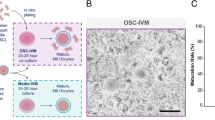Abstract
Purpose
Evaluate the effect of short gamete incubation on fertilization rate and embryo quality.
Methods
A prospective study has been performed. Two thousand five hundred and forty seven sibling oocytes from 240 couples undergoing IVF attempts were allocated to a short (1 h) or a standard (18 h) insemination procedure. Diploid fertilization rate (two pronuclei, 2PN), polyspermy (>2PN) and embryo quality were compared.
Results
The fertilization rate was statistically lower in the short insemination group compared to the standard insemination one (64.9% and 70.1%; P = 0.039), with a similar polyspermy rate observed between the two groups. A slight, but non significant, increase was observed concerning good embryo quality rate in the short insemination group when compared to the standard insemination, both at day 2 (60.1 vs. 58.1%; P = 0.06) and day 3 (53.2 vs. 48.5%; P = 0.22).
Conclusion
This new study highlights that a 1 h gamete exposure decreases the fertilization rate and does not improve embryo quality compared with a standard 18 h insemination procedure.

Similar content being viewed by others
References
Wassarman PM. The biology and chemistry of fertilization. Science. 1987;235:553–60. doi:10.1126/science.3027891.
Wassarman PM. Fertilization in mammals. Sci Am. 1988;259:78–84.
Gianaroli L, Cristina Magli M, Ferraretti AP, Fiorentino A, Tosti E, Panzella S, et al. Reducing the time of sperm–oocyte interaction in human in-vitro fertilization improves the implantation rate. Hum Reprod. 1996;11:166–71.
Gianaroli L, Fiorentino A, Magli MC, Ferraretti AP, Montanaro N. Prolonged sperm–oocyte exposure and high sperm concentration affect human embryo viability and pregnancy rate. Hum Reprod. 1996;11:2507–11.
Plachot M, Junca AM, Mandelbaum J, Cohen J, Salat-Baroux J, Da Lage C. Timing of in-vitro fertilization of cumulus-free and cumulus-enclosed human oocytes. Hum Reprod. 1986;1:237–42.
Aitken RJ, Clarkson JS. Cellular basis of defective sperm function and its association with the genesis of reactive oxygen species by human spermatozoa. J Reprod Fertil. 1987;81:459–9. doi:10.1530/jrf.0.0810459.
Aitken RJ. A free radical theory of male infertility. Reprod Fertil Dev. 1994;6:19–23. discussion 23–4. doi:10.1071/RD9940019
Twigg J, Fulton N, Gomez E, Irvine DS, Aitken RJ. Analysis of the impact of intracellular reactive oxygen species generation on the structural and functional integrity of human spermatozoa: lipid peroxidation, DNA fragmentation and effectiveness of antioxidants. Hum Reprod. 1998;13:1429–36. doi:10.1093/humrep/13.6.1429.
Nasr-Esfahani M, Johnson MH, Aitken RJ. The effect of iron and iron chelators on the in-vitro block to development of the mouse preimplantation embryo: BAT6 a new medium for improved culture of mouse embryos in vitro. Hum Reprod. 1990;5:997–1003.
Dirnfeld M, Bider D, Koifman M, Calderon I, Abramovici H. Shortened exposure of oocytes to spermatozoa improves in-vitro fertilization outcome: a prospective, randomized, controlled study. Hum Reprod. 1999;14:2562–4. doi:10.1093/humrep/14.10.2562.
Kattera S, Chen C. Short coincubation of gametes in in vitro fertilization improves implantation and pregnancy rates: a prospective, randomized, controlled study. Fertil Steril. 2003;80:1017–21. doi:10.1016/S0015-0282(03)01154-3.
Coskun S, Roca GL, Elnour AM, al Mayman H, Hollanders JM, Jaroudi KA. Effects of reducing insemination time in human in vitro fertilization and embryo development by using sibling oocytes. J Assist Reprod Genet. 1998;15:605–8. doi:10.1023/A:1020333427698.
Lin SP, Lee RK, Su JT, Lin MH, Hwu YM. The effects of brief gamete co-incubation in human in vitro fertilization. J Assist Reprod Genet. 2000;17:344–8. doi:10.1023/A:1009409229068.
Lundqvist M, Johansson U, Lundkvist O, Milton K, Westin C, Simberg N. Reducing the time of co-incubation of gametes in human in-vitro fertilization has no beneficial effects. Reprod Biomed Online. 2001;3:21–4.
Swenson K, Check JH, Summers-Chase D, Choe JK, Check ML. A randomized study comparing the effect of standard versus short incubation of sperm and oocyte on subsequent pregnancy and implantation rates following in vitro fertilization embryo transfer. Arch Androl. 2000;45:73–6. doi:10.1080/014850100410042.
Bungum M, Bungum L, Humaidan P. A prospective study, using sibling oocytes, examining the effect of 30 seconds versus 90 minutes gamete co-incubation in IVF. Hum Reprod. 2006;21:518–23. doi:10.1093/humrep/dei350.
WHO. WHO laboratory manual for examination of human semen and semen-cervical mucus interaction. Cambridge University Press 1999; Cambridge:UK
Sifer C, Sasportes T, Barraud V, Poncelet C, Rudant J, Porcher R, et al. World Health Organization grade ‘a’ motility and zona-binding test accurately predict IVF outcome for mild male factor and unexplained infertilities. Hum Reprod. 2005;20:2769–75. doi:10.1093/humrep/dei118.
Plachot M, Belaisch-Allart J, Mayenga JM, Chouraqui A, Tesquier L, Serkine AM. Outcome of conventional IVF and ICSI on sibling oocytes in mild male factor infertility. Hum Reprod. 2002;17:362–9. doi:10.1093/humrep/17.2.362.
Tournaye H, Verheyen G, Albano C, Camus M, Van Landuyt L, Devroey P, et al. Intracytoplasmic sperm injection versus in vitro fertilization: a randomized controlled trial and a meta-analysis of the literature. Fertil Steril. 2002;78:1030–7. doi:10.1016/S0015-0282(02)03377-0.
Hu FB, Goldberg J, Hedeker D, Flay BR, Pentz MA. Comparison of population-averaged and subject-specific approaches for analyzing repeated binary outcomes. Am J Epidemiol. 1998;147:694–703.
Quinn P, Lydic ML, Ho M, Bastuba M, Hendee F, Brody SA. Confirmation of the beneficial effects of brief coincubation of gametes in human in vitro fertilization. Fertil Steril. 1998;69:399–402. doi:10.1016/S0015-0282(97)00576-1.
Author information
Authors and Affiliations
Corresponding author
Additional information
Capsule This study highlights that a 1 h gamete exposure decreases the fertilization rate and does not improve embryo quality compared with a standard 18 h insemination procedure.
Rights and permissions
About this article
Cite this article
Barraud-Lange, V., Sifer, C., Pocaté, K. et al. Short gamete co-incubation during in vitro fertilization decreases the fertilization rate and does not improve embryo quality: a prospective auto controlled study. J Assist Reprod Genet 25, 305–310 (2008). https://doi.org/10.1007/s10815-008-9240-3
Received:
Accepted:
Published:
Issue Date:
DOI: https://doi.org/10.1007/s10815-008-9240-3




